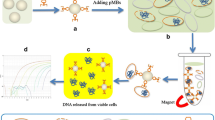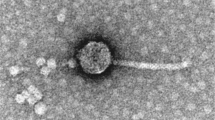Abstract
Double-layer plaque assay technique (DLA) can be used to enumerate, isolate, and detect bacteriophages in food, beverage, and water samples. DLA technique allows phage contact with host bacterium in an environment containing two layers of agar. The phage infects the host bacterium, and translucent or clear zones (plaques) appear containing phage particles and lysed bacteria. Enumeration of phages requires a short time of analysis. It is a simple and efficient method applicable to various bacteriophages. In this chapter, we used MS2 Human Norovirus surrogate as an example.
Access provided by Autonomous University of Puebla. Download chapter PDF
Similar content being viewed by others
Key words
1 Introduction
Foodborne viruses are classified as enteric viruses and replicate in the host gastrointestinal tract . However, the difficulty in assessing the survival of Human Noroviruses (NoVs) in food is the non-replication of NoVs without using host cell culture, requiring a complex experimental approach for manipulation in microbiological research [1].
Viral substitutes as bacteriophages are often used in research due to the complexity of the cell culture systems necessary to propagate viruses that infect humans [1]. Substitutes are typically selected due to morphological and physiological characteristics similar to the pathogens of interest. They should be equivalent to or slightly more resistant to treatments than the target organism. Moreover, they should be nonpathogenic and present similar growth and survival behavior [2]. In this sense, substitutes (surrogates) have been used to estimate the behavior of foodborne pathogenic enteric viruses in foods and water.
The double-layer plaque assay technique is the classical method used in phage research for enumeration , isolation , and detection of bacteriophages . It is also used to isolate mutants and new phages and characterize the plaque ’s morphology (size of the plaque , presence/absence of a halo, and clear versus turbid lysis) [3, 4].
This technique is also known as double agar overlay plaque assay , double layer, soft agar overlay, or double agar layer [4]. The technique involves phage suspensions grown with host bacterium in a dilute molten agar (overlay or top agar ) dispersed onto a solid medium (underlay or bottom agar ) [5]. The top agar is commonly referred to as soft agar and contains the same medium of bottom agar , however, with a lower agar concentration. The bottom agar is used for bacterial growth containing 1–1.5% agar [6]. Phages can be directly inoculated on top of the second layer and dried or mixed with the host bacterium and the soft agar [7].
During the incubation period (optimal temperature and time for bacterial growth ), the host bacterium forms a lawn on the solid medium, except when infectious phage particles inhibit the growth or lyse the cells, resulting in a translucent or clear zone (visible to the naked eye), termed a plaque . Each plaque represents a single phage particle in the original sample. Sufficient progeny phages from each infected bacterial cell are needed for plaque expansion, allowing localized infection, lysis, or altered bacteria growth [4]. However, some phage plaques are difficult to distinguish because of the nature of the phage , small size, or incomplete lysis. In this case, to facilitate plaque formation, the agarose can be used in lower concentration (0.2%) to replace the agar [8], and divalent ions (CaCl2 and MgCl2) can be added to allow phage adsorption to the bacterial receptor [9].
Enumeration of phages by the double-layer plaque assay technique is an efficient and simple method , applicable to many bacteriophages and can be implemented with minimal costs [7]. However, it may show high variability. Therefore, the optimization of each phage-host can be time-consuming. Moreover, cross contamination with other bacteria and other phages and changes in the host’s growth behavior can significantly impact the results [10]. This chapter describes the application of the double-layer plaque assay technique for enumeration of MS2, a NoV surrogate.
2 Materials
-
1.
Culture tools: Variable or fixed-volume micropipettes (see Note 1), sterile pipette tips, sterile plastic10- to 20-mL tubes and petri dishes (90 mm).
-
2.
Growth media: Trypticase Soy Agar (TSA), Trypticase Soy Broth (TSB), and Bacteriological agar.
-
3.
Equipment: Water bath or heating block maintaining at 40 ± 1.0 °C, incubator stabilized at 36 ± 1.0 °C for growth of microorganisms, autoclave at 121 °C, and vortex.
2.1 Single-Layer Plaque or Bottom Agar
-
1.
Prepare the TSA medium according to the manufacturer’s instructions and sterilize it in an autoclave at 121 °C for 15 min.
-
2.
When the medium cools down to 50 ± 1.0 °C, dispense ~20 mL of medium per petri dish. Keep the petri dishes in the safety cabinet until solidification (see Note 2).
-
3.
If necessary, the petri dishes can be stored at 4 ± 1.0 °C for up to 7 days. Before using the petri dishes containing TSA stored, let them dry to avoid possible interference of condensed water (see Note 3).
2.2 Double-Layer Plaque or Top Agar
-
1.
Prepare the TSB medium according to the manufacturer’s instructions, with the addition of bacteriological agar to a concentration of 0.5%.
-
2.
Warm the medium (TSB + agar of 0.5%; soft agar) to melt the agar (agar melting temperature range from 85 °C to 95 °C).
-
3.
Sterilize the medium (soft agar) in an autoclave at 121 °C for 15 min.
-
4.
Dispense ~5 mL of medium (soft agar) into sterile plastic tubes.
-
5.
If needed, store them at 4 °C up to 7 days. Before use, stored tubes containing soft agar should be warmed (see Note 4).
2.3 Trypticase Soy Broth
-
1.
Prepare the TSB medium according to the manufacturer’s instructions and sterilize it in an autoclave at 121 °C for 15 min.
-
2.
Distribute volumes previously fixed (9 mL or 900 μL) in sterile plastic tubes or sterile Eppendorf.
2.4 Overnight Host Bacteria Stock Cultures
-
1.
If petri dishes containing TSA were stored at 4 °C, let them dry before the experiment (see Note 3).
-
2.
Inoculate the loopful of E. coli C3000 (or equivalent bacteriophage host) directly from the stock culture (see Note 5) in petri dishes containing TSA.
-
3.
Overnight incubate the petri dishes at 36 ± 1.0 °C.
-
4.
Transfer a single colony to 9 mL of TSB and overnight incubate at 36 ± 1.0 °C.
-
5.
Harvest cells by centrifugation (5000 × g, 4 °C for 15 min) and adjust the inoculum to the estimated level (approximately 8 log CFU/mL).
3 Methods
3.1 Double Agar Overlay Plaque Assay (Fig. 1)
-
1.
Identify the petri dishes containing TSA using the number of the corresponding dilution to be inoculate (e.g., −1 to −9).
-
2.
Add the overnight culture of E. coli C3000 (or equivalent bacteriophage host) in 50 mL of medium (1:50; soft agar) at 40 ± 1.0 °C. Mix and pour the contents (~5 mL) over the surface of TSA (see Notes 4, 6 and 7).
-
3.
Wait for the solidification of layers for 30 min (see Note 8).
-
4.
Separate ten sterile Eppendorf and add 900 μL of TSB (or equivalent diluent) in each tube and identify them with sequential numbers corresponding to the dilutions (e.g., −1 to −9).
-
5.
Add 100-μL of MS2 stock bacteriophage (or another bacteriophage ) to the first Eppendorf, vortex it, change the pipette tip and transfer 100 μL to the second Eppendorf in the series (see Note 9).
-
6.
Inoculate 100 μL of each dilution on the surface of TSA (full dish).
-
7.
Incubate the petri dishes at 36 ± 1.0 °C overnight (see Note 10).
-
8.
Count the plates formed in the TSA in contrast to white light.
4 Data Analysis and Calculations
-
1.
Count the number of plaque-forming units (PFU) in plaque counts within the desired range of 30–300 PFU.
-
2.
Use the following equation for determine the titer of the original phage preparation:
5 Notes
-
1.
To avoid cross-contamination , micropipettes should be cleaned before use and periodically calibrated.
-
2.
To avoid condensation of water on the petri dishes, the agar must be dried in the biological safety cabinet, with sterile air flowing directly above the agar.
-
3.
Stored TSA petri dishes should be partially uncovered in a safety cabinet for 10–15 min to reduce condensation before inoculation .
-
4.
Before use, soft agar stored at 4 °C up to 7 days in tubes should be warm to 40 ± 1.0 °C in a water bath or heating block. The soft agar must be completely melted to avoid crystalline areas in the overlayer that difficult to enumerate the PFU.
-
5.
Stock cultures of the host strain should be maintained at −80 °C, and used to prepare the working cultures for the analysis.
-
6.
The temperature of 40 ± 1.0 °C needs to be strictly controlled to maintain the host viability .
-
7.
5 mL of soft agar is sufficient for the overlayer onto the solid TSA in one petri dish.
-
8.
The petri dishes must always be opened in the biological safety cabinet.
-
9.
Sufficient mixing is achieved with a low setting in a vortex for ~30 s. Long mixing times are not recommended for phage suspensions.
-
10.
E. coli C3000 can grow fast; therefore, plaques may be visible after few hours of incubation .
References
Sharps CP, Kotwal G, Cannon JL (2012) Human norovirus transfer to stainless steel and small fruits during handling. J Food Prot 75:1437–1446
Mikel P, Vasickova P, Tesarik R, Malenovska H, Kulich P, Vesely T, Kralik P (2016) Preparation of MS2 phage-like particles and their use as potential process control viruses for detection and quantification of enteric RNA viruses in different matrices. Front Microbiol 7:1911
Adams MD (1959) Bacteriophages. Interscience Publishers, New York
Kropinski AM, Mazzocco A, Waddell TE, Lingohr ER, Johnson P (2009) Enumeration of bacteriophages by double agar overlay plaque assay. Methods Mol Biol 501:69–76
Cormier J, Janes M (2014) A double layer plaque assay using spread plate technique for enumeration of bacteriophage MS2. J Virol Methods 196:86–92
Abedon ST, Yin J (2009) Bacteriophage plaques: theory and analysis. Methods Mol Biol 501:161–174
Ács N, Gambino M, Brøndsted L (2020) Bacteriophage enumeration and detection methods. Front Microbiol 11:594868
Serwer P, Hayes SJ, Thomas JA, Hardies SC (2007) Propagating the missing bacteriophages: a large bacteriophage in a new class. Virol J 4:21
Serwer P, Hayes SJ, Zaman S, Lieman K, Rolando M, Hardies SC (2004) Improved isolation of undersampled bacteriophages: finding of distant terminase genes. Virology 329:412–424
Anderson B, Rashid MH, Carter C, Pasternack G, Rajanna C, Revazishvili T, Dean T, Senecal A, Sulakvelidze A (2011) Enumeration of bacteriophage particles. Bacteriophage 1:86–93
Author information
Authors and Affiliations
Editor information
Editors and Affiliations
Rights and permissions
Copyright information
© 2021 The Author(s), under exclusive license to Springer Science+Business Media, LLC, part of Springer Nature
About this chapter
Cite this chapter
da Silva, R.T., de Souza Grilo, M.M., Magnani, M., de Souza Pedrosa, G.T. (2021). Double-Layer Plaque Assay Technique for Enumeration of Virus Surrogates. In: Magnani, M. (eds) Detection and Enumeration of Bacteria, Yeast, Viruses, and Protozoan in Foods and Freshwater. Methods and Protocols in Food Science . Humana, New York, NY. https://doi.org/10.1007/978-1-0716-1932-2_14
Download citation
DOI: https://doi.org/10.1007/978-1-0716-1932-2_14
Published:
Publisher Name: Humana, New York, NY
Print ISBN: 978-1-0716-1931-5
Online ISBN: 978-1-0716-1932-2
eBook Packages: Springer Protocols





